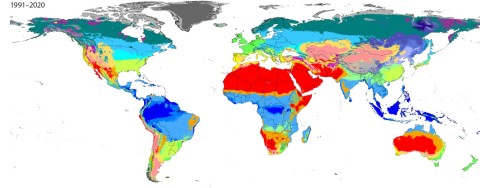

Thuwal, Saudi Arabia, 23 October 2023 / Sciad Newswire / A multinational study seen in Scientific Data and led by KAUST reports that the global climate has experienced notable changes in climate classification over the past century, and these shifts are projected to intensify in the coming decades. With an updated version of the 1-km Kӧppen-Geiger climate classification maps released in 2018, the study provides a comprehensive view of historical and future climate conditions across the globe.
"These new maps offer a more refined and broader perspective," explained KAUST Assistant Professor Hylke Beck, lead author of the study, about the information gained from the new version.
The Köppen-Geiger classification is an essential tool for understanding global climate. Originating in the late 19th century, it divides the world's land climate into five major classes based on air temperature and precipitation patterns. This classification aligns with the global vegetation distribution, making it a vital tool for ecological and ecohydrological applications as well as climate change impact assessments.
The updated maps incorporate historical data from four periods, ranging from 1901 to 2020, and projections for two future periods extending up to 2099 for various socioeconomic scenarios. The researchers used a refined selection from 67 climate models, but excluded models with unrealistic CO2-induced warming rates, to ensure the highest accuracy.
One of the most notable findings is the projected shift in land surface climate. Specifically, researchers anticipate an area roughly the size of Argentina, the world's eighth largest country, or 2.6 million km², to transition from polar to cold climates by 2071-2099 under the shared socioeconomic pathways (SSP)2-4.5 scenario, which assumes greenhouse gas emissions will approach zero by the end of the century. Additionally, 2.4 million km² is projected to shift from cold to temperate, 1.1 million km² from cold to arid, and 2.8 million km² from temperate to tropical regions.
However, the study also emphasized that actual vegetation changes may not necessarily occur in concert with these classifications. Beck notes, “Changes are likely to occur gradually through the process of succession, in which plants and animals steadily colonize and modify an ecosystem over time.”
With the previous version of the maps cited over 3,000 times, this updated version promises to be an invaluable resource for researchers, policymakers, and the broader community.
ENDS
For further information, please contact:
Sciad Communications, Media Relations
Amy Thomas
E: kaust@sciad.com
T: +44 (0)20 3405 7892
Notes for Editors
Image Caption: “Köppen-Geiger maps of different time periods. Reproduced with modifications under CC BY license from Beck et al., 2023."
About KAUST
Established in 2009, King Abdullah University of Science and Technology (KAUST) is a graduate research university devoted to finding solutions for some of the most pressing scientific and technological challenges in the world as well as Saudi Arabia in the areas of food and health, water, energy, environment and the digital domain. KAUST is a curiosity-driven, interdisciplinary problem-solving environment, with state-of-the-art labs, distinguished faculty and talented students.
KAUST brings together the best minds from around the world to advance research. More than 110 different nationalities live, work and study on campus. KAUST is also a catalyst for innovation, economic development and social prosperity, with research resulting in novel patents and products, enterprising startups, regional and global initiatives, and collaboration with other academic institutions, industries and Saudi agencies.
For additional information, visit www.kaust.edu.sa.
